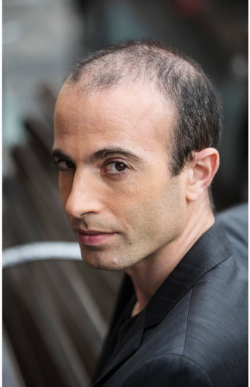Siddhartha Mukherjee in The New York Times:
 “Organisms are algorithms,” Yuval Noah Harari asserts in his provocative new book, “Homo Deus.” “Every animal — including Homo sapiens — is an assemblage of organic algorithms shaped by natural selection over millions of years of evolution. . . . There is no reason to think that organic algorithms can do things that nonorganic algorithms will never be able to replicate or surpass.” In Harari’s telling, the human “algorithm” will soon be overrun and outpaced by other algorithms. It is not the specter of mass extinction that is hanging over us. It is the specter of mass obsolescence. To understand how Harari arrives at this conclusion, we might turn to his earlier book. “Sapiens: A Brief History of Humankind” was an attempt to write a genetic, anthropological, cultural, social and epistemological history of humans over the last 100,000-odd years. Historians, scientists and academic pedants carped about its audacity of scope — but the book, modeled after Jared Diamond’s “Guns, Germs, and Steel” (a book that also received its share of carping and academic envy), presented a sweeping macrohistory, often marvelously. From the birth of a slight, sly, naked ape somewhere in the depths of Africa to the growth, spread and eventual dominance of that species over the world, “Sapiens” split the story of humankind into three broad “revolutions.” The first, the “cognitive revolution,” resulted in humans acquiring the capacity to think, learn and communicate information with a facility unprecedented in the animal kingdom. The second — the “agricultural revolution” — allowed humans to domesticate crops and animals, enabling us to form stable societies and intensifying the flow of information within them. The “scientific revolution” came last. Humans acquired the capacity to interrogate and manipulate the physical, chemical and biological worlds, resulting in even more potent technological advances that surround us today.
“Organisms are algorithms,” Yuval Noah Harari asserts in his provocative new book, “Homo Deus.” “Every animal — including Homo sapiens — is an assemblage of organic algorithms shaped by natural selection over millions of years of evolution. . . . There is no reason to think that organic algorithms can do things that nonorganic algorithms will never be able to replicate or surpass.” In Harari’s telling, the human “algorithm” will soon be overrun and outpaced by other algorithms. It is not the specter of mass extinction that is hanging over us. It is the specter of mass obsolescence. To understand how Harari arrives at this conclusion, we might turn to his earlier book. “Sapiens: A Brief History of Humankind” was an attempt to write a genetic, anthropological, cultural, social and epistemological history of humans over the last 100,000-odd years. Historians, scientists and academic pedants carped about its audacity of scope — but the book, modeled after Jared Diamond’s “Guns, Germs, and Steel” (a book that also received its share of carping and academic envy), presented a sweeping macrohistory, often marvelously. From the birth of a slight, sly, naked ape somewhere in the depths of Africa to the growth, spread and eventual dominance of that species over the world, “Sapiens” split the story of humankind into three broad “revolutions.” The first, the “cognitive revolution,” resulted in humans acquiring the capacity to think, learn and communicate information with a facility unprecedented in the animal kingdom. The second — the “agricultural revolution” — allowed humans to domesticate crops and animals, enabling us to form stable societies and intensifying the flow of information within them. The “scientific revolution” came last. Humans acquired the capacity to interrogate and manipulate the physical, chemical and biological worlds, resulting in even more potent technological advances that surround us today.
“Homo Deus” takes off where “Sapiens” left off; it is a “brief history of tomorrow.” What is the natural culmination of the scientific revolution, Harari asks. What will the future look like? “At the dawn of the third millennium,” he writes, “humanity wakes up, stretching its limbs and rubbing its eyes. Remnants of some awful nightmare are still drifting across its mind. ‘There was something with barbed wire, and huge mushroom clouds. Oh well, it was just a bad dream.’ Going to the bathroom, humanity washes its face, examines its wrinkles in the mirror, makes a cup of coffee and opens the diary, ‘Let’s see what’s on the agenda today.’ ” This is the kind of breezy prose that has catapulted Harari into an international star — and it is equally evident in this book. I’ll return to that brushed-off nightmare — the barbed wire and mushroom clouds — but Harari continues apace: “Having raised humanity above the beastly level of survival struggles, we will now aim to upgrade humans into gods, and turn Homo sapiens into Homo deus.”
More here.
Imagine you are asked to compose an ultra-short history of philosophy. Perhaps you’ve been challenged to squeeze the impossibly sprawling diversity of philosophy itself into just a few tweets. You could do worse than to search for the single word that best captures the ideas of every important philosopher. Plato had his ‘forms’. René Descartes had his ‘mind’ and John Locke his ‘ideas’. John Stuart Mill later had his ‘liberty’. In more recent philosophy, Jacques Derrida’s word was ‘text’, John Rawls’s was ‘justice’, and Judith Butler’s remains ‘gender’. Michel Foucault’s word, according to this innocent little parlour game, would certainly be ‘power’.
